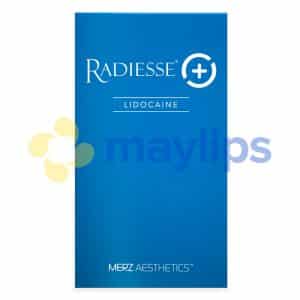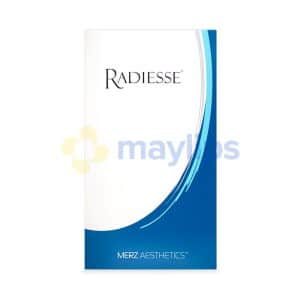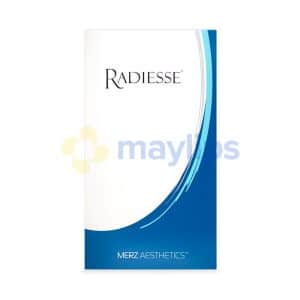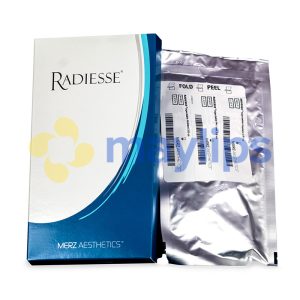Showing all 5 results
Buy RADIESSE® Products From Leading Wholesaler At Low Prices
Buy RADIESSE® Products From Leading Wholesaler At Low Prices
-


RADIESSE® (+) 0.8ml w / Lidocaine
1-0.8ml prefilled syringe
89.00 $ Add To Cart-+

RADIESSE® (+) 1.5ml w / Lidocaine
1-1.5ml prefilled syringe
149.00 $ Add To Cart-+

RADIESSE® 0.8ml
1-0.8ml prefilled syringe
79.00 $ Add To Cart-+

RADIESSE® 1.5 ml
1-1.5ml prefilled syringe
119.00 $ Add To Cart-+

RADIESSE® 3 ml
1-3ml syringe
449.00 $ Add To Cart-+*Disclaimer: The following information on Maylips.com is provided for informational purposes only. Self-application is strictly prohibited. All aesthetic procedures should be performed by a licensed healthcare specialist after the consultation with the client seeking facial filler treatment. The information contained in this article should not be used for prescribing any medication for the purpose of beauty injections.
All of the brand and medication descriptions in the article are based on personal opinion and are not endorsed by Maylips.com. The article content has not been reviewed for medical validity. Use this article for informational purposes only; it is not suitable for making a final decision on the procedure to apply a product.
What Is Radiesse, and How Does It Work?
Radiesse is a new-generation filler designed for non-surgical facial correction, creating a long-lasting wrinkle-smoothing effect.
Radiesse manufacturer Merz Aesthetics made its product of 2 primary components: carrier gel and microcrystals of calcium hydroxylapatite, which, from the first days of being in the tissues, trigger the synthesis of new collagen.
Calcium Hydroxylapatite (CaHA) is the main mineral component of bone tissue and teeth. This component is well-studied, has a high safety profile, and has been used in dentistry, ophthalmology, and other medical fields for over 20 years.
Radiesse seemingly natural adds volume and structure augmentation to the treated area when injected into the skin by a medical specialist. The gel provides immediate volume, while the microspheres act as a scaffold, stimulating the body’s natural production over time. As Radiesse products are gradually metabolized by the body, the newly formed substance helps keep the rejuvenated appearance of the treated area.
What Is Radiesse Used For?
Using different dilution techniques, Radiesse products are excellent for any body part. If Radiesse is in a less concentrated state, it perfectly stimulates the body to synthesize collagen naturally. If the specialist uses micro-needles or a flexible cannula, the filler copes with age and aesthetic problems in areas with thin, flabby skin or insufficient volume. Also consider to purchase Radiesse Lidocaine when you are deciding on a product to order to restore that youthful lifting appearance.
But most commonly, like some other cosmetic fillers products Radiesse Lidocaine is used for the following medical and aesthetic purposes:
- Wrinkle Reduction: Used to soften and reduce wrinkles and fine lines, particularly those around the nose (nasolabial folds), mouth (marionette lines), and chin.
- Facial Contouring: These fillers can be used to enhance and restore facial contours, such as cheekbones, jawline, and chin, providing a more youthful and balanced appearance.
- Volume Restoration: To replace lost volume in areas that have experienced age-related volume depletion, such as the cheeks and temples, giving a natural lifting effect to skin Radiesse treatment is a great option.
- Scar Treatment: In some cases, may be used to enhance the appearance of certain types of scars, particularly those that have caused depressions or volume loss.
- Collagen Stimulation: This fillers unique composition stimulates the body’s natural collagen production, which helps improve skin texture, elasticity, and overall quality over time.
- Jawline Definition: Injections can help create a more defined and sculpted jawline, enhancing facial symmetry and aesthetics.
How Long Lasting Is One Vial Of Radiesse?
The first results will be visible immediately after the product Radiesse is injected, and the final effect will be visible after 5-7 days. This is only one filler Radiesse natural advantage many consider when they order. The treatment’s long-lasting correction results will last for 1-2 years. After that, the procedure should be repeated. On the doctor’s agreement, it is possible to intermittently carry out additional support injections.
How Much Does It Cost To Buy Radiesse Online?
The exact price of the fillers Radiesse products range varies depending on the variation of Radiesse to order as well as the dosage the customer needs. To obtain exact Radiesse filler price, make sure to browse the Radiesse product range at the MayLips.com shop and contact us for more information. In-stock notification is updated regularly, for those interested to order Radiesse on our online shop in any volume. The add cart function is great for anyone interested to buy Radiesse online. Available in different sizes of pack Radiesse can fit any need.
How Much Does One Syringe Of Radiesse Cost?
Many people wonder why it is so expensive to purchase Radiesse online from a regular shop or even a wholesaler. The reality is that Radiesse filler is worth the money; Just look at all the treatment options and product ingredients. Also, compare all the great reviews from customers and patients who have received treatment with Radiesse sourced from Radiesse wholesale suppliers. Also reviews are there from specialists who order Radiesse and perform procedures regularly.
Is Radiesse Dermal Product Safe For Skin And Worth The Cost?
The product is generally considered safe when you purchase Radiesse fillers from a reliable wholesaler and administered by qualified healthcare professionals for approved cosmetic and medical uses. Like any invasive procedure, there are potential risks and considerations, which we will discuss in the following paragraphs. However, patients need to consult with their healthcare provider before undergoing treatment. Also important for specialists to know what is needed for when it comes time to order or proceed to cart view after deciding on purchasing Radiesse wholesale.
Radiesse Benefits for a customer:
- Instant effect – the result is noticeable immediately after the procedure. During the month, while the preparation is distributed in the tissues, it only increases.
- Hypoallergenic – thanks to its composition, Radiesse usually does not cause a dermal allergic reaction.
- Deep wrinkles correction – Radiesse is able to cope with age skin wrinkles and creases, which conventional hyaluronic acid-based fillers only smooth out. It restores the missing soft tissue, returns the desired volume to the face, and allows to model the appearance.
- Long-lasting effect – the product has a prolonged action. It fills wrinkles immediately, restoring the desired fullness. One procedure allows the patient to forget about age-related changes for a year or even more!
Radiesse Contraindications
Before the procedure, a doctor’s consultation is carried out. A certified cosmetologist/dermatologist examines the patient for treatment with Radiesse, reviews his medical history, and checks for contraindications on their medical history account. These include:
- Autoimmune diseases;
- Blood clotting disorders and any blood diseases;
- Chronic diseases in severe form or exacerbation stage;
- Skin inflammation;
- Any conditions and infections accompanied by an increase in body temperature;
- Mental illnesses;
- Pregnancy and lactation period;
- Insulin-dependent diabetes mellitus;
- Hypersensitivity to the components;
Radiesse Fillers Side Effects
Even though it may be rare, some people may have the following side effects:
- Redness, swelling, and bruising at the injection site.
- Rarely, infection or allergic reactions.
- Possibility of granuloma formation (small nodules) or product migration.
- Excessive stimulation leading to lumps or irregularities.
- Mild discomfort during or after injection.
Important: Don’t put patients at risk trying to cut Radiesse costs with non-licensed dermal fillers. Minimize side effects by choosing as a customer to buy Radiesse genuine products from reputable suppliers.
Radiesse Aftercare
The recovery period after the Radiesse dermal injection takes approximately 24 hours. During this period, cold compresses can be united with the injection site. Swelling may be noticeable – it is common and will subside in a few hours. However, patients should consult a doctor if they experience pain or fever.
What to avoid after a Radiesse treatment:
- Using makeup or dermal skin cleansers for the first 24 hours;
- Taking blood thinners for 48 hours after the session;
- Visiting steam baths or saunas for the first 14 days;
- Skin being exposed to direct sunlight without sunscreen;
- Using facial peels.
What Is Radiesse Made Of?
Radiesse ingredients list consists of calcium hydroxylapatite in the form of microspheres (comprising 30% of its composition) and an aqueous gel carrier (constituting 70% of its composition). Calcium hydroxylapatite is synthetically produced; however, its composition is entirely identical to the substances found in human teeth and bones.

